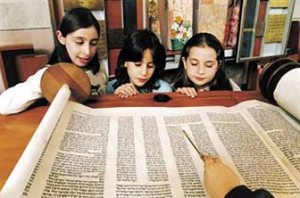[PCJE Dvar Torah] Parshat Terumah – A Guide to Classroom Teaching by Avi Spodek
Posted on February 14, 2013 by The Director of Digital Media
Tags: dvar Torah, Jewish education, Mazal Tov!, opportunities, Pardes Center for Jewish Educators (PCJE), Parsha / Parasha, Parshat Truma, PCJE Dvar Torah, relevance, Shechina, student teaching, Tabernacle / Mishkan

Starting Tuesday, my fellow Pardes Educators will enter a variety of Jewish day school classrooms across the US as part of their student teaching experience. With an eye toward this opportunity, here are a few lessons/ideas from this week’s Torah portion, Parshat Terumah, regarding pedagogy:
- The parsha opens with an appeal for donations of the materials necessary for building the Mishkan (the Tabernacle). Every Israelite was encouraged to donate, so that the Mishkan became a unified source of the Shechinah (GD’s presence) in which everyone claimed a portion.
Our classrooms, too, should function on this precept. If we aim to foster a community of learners where everyone has buy-in we should solicit feedback and ideas from our students and incorporate them into our teaching. This is also known as a constructivist classroom.
- The parsha continues and provides a detailed blueprint for construction of the Mishkan and its objects. The blueprint lists the necessary materials, the measurement of the objects and their placement within the Mishkan, in such a way that they can be reproduced by almost anyone.
As teachers, when we plan our lessons, we must be as explicit and detailed as possible. We must know what it is that we want to produce and be capable of breaking down the necessary logistics in such a way that our students can complete the task. These lessons plans should be so detailed that almost anyone could carry them out.
- The parsha list a variety of objects inside of the Mishkahn, such as the Aron (ark), the Shulkhan (table for the showbread), the Menorah (candelabra) and the Mizbeach (altars) that were each used in their own way as a form of worshipping GD.
While a detailed and structured lesson plan are essential, our approach in the classroom needs to be flexible. Our students come to us with differing levels of abilities and intelligences and it is incumbent upon us to create lessons that appeal to each of those modes of learning. This is a model of the differentiated classroom.
- The parsha tells us that the construction of the Mishkan included rings and poles for carrying it throughout the wilderness, as it was meant to travel with the Israelites wherever they went.
When educating our students, we must always search for the relevance and application of our lessons. We need to ensure that what our students are being taught has meaning beyond the classroom walls and in addition to pure academics, so that the students can carry the knowledge beyond the classroom. These are the big ideas and enduring understandings of what we teach.
 The Pardes educators have learned a lot in the past six months about the science and art of teaching. They now have the opportunity to put it all together in their classrooms over the next few weeks.
The Pardes educators have learned a lot in the past six months about the science and art of teaching. They now have the opportunity to put it all together in their classrooms over the next few weeks.
I wish them the best of luck and the greatest of success in their endeavor.
Shabbat Shalom.

 The Pardes educators have learned a lot in the past six months about the science and art of teaching. They now have the opportunity to put it all together in their classrooms over the next few weeks.
The Pardes educators have learned a lot in the past six months about the science and art of teaching. They now have the opportunity to put it all together in their classrooms over the next few weeks.